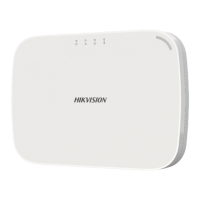What to do if zone is offline on HIKVISION Control Panel?
- JjohnfrancoSep 10, 2025
If a zone is offline on your HIKVISION Control Panel, check whether the detector reports undervoltage and replace the detector battery.

What to do if zone is offline on HIKVISION Control Panel?
If a zone is offline on your HIKVISION Control Panel, check whether the detector reports undervoltage and replace the detector battery.
What to do if zone is triggered/fault on HIKVISION Control Panel?
If a zone is triggered or shows a fault on your HIKVISION Control Panel, reset the detector.
What to do if failure in arming (when the arming process is not started) on HIKVISION Control Panel?
If arming fails on your HIKVISION Control Panel when the arming process is not started, turn on the "forced arming" enable, or restore the zone to the normal status.
Why the alarm clearing operation on the panel does not produce the alarm clearing report on HIKVISION Control Panel?
If the alarm clearing operation on the HIKVISION Control Panel does not produce the alarm clearing report, it is because in the absence of alarm, no report will be uploaded for arm clearing.
| Model | DS-PHA20-P |
|---|---|
| Category | Control Panel |
| Wireless Zones | 32 |
| Siren Output | 1 |
| Onboard Siren | Yes |
| Event Log | 1000 events |
| Power Supply | DC 12V |
| Battery Type | Lithium battery |
| Operating Temperature | -10°C to +55°C |
| Operating Humidity | 10% to 90% (non-condensing) |
| Power Consumption | 10 W |
| Wired Outputs | 2 (Expandable to 4) |
Steps to activate device using a web browser.
Steps to activate device using client software.
Steps to activate device using the SADP tool.
How to configure the control panel using client software.
How to configure the control panel using the web client.
Configure wired, Wi-Fi, and cellular network parameters.
Set up parameters for the alarm receiving center.
Configure settings for sending alarm notifications.
Using the mobile client for device management and monitoring.
Steps to download and log into the Hik-Connect mobile client.
Activating the control panel using the Hik-Connect service.
Adding the control panel to the mobile client app.
Adding external peripherals like detectors to the control panel.
Adding RFID cards for system access.
Adding keyfobs for system access and control.
Managing user accounts and permissions.
Configuring various system-wide settings and options.
Procedures for arming the security system.
Procedures for disarming the security system.
Using the keyfob to control system operations.
Using the RFID card to control system operations.
Performing system operations using client software.
Steps to add a device to the client software.
Adding devices to client software via Cloud P2P.
Performing system operations using the web client.
Managing RFID tags (cards).
Managing keyfobs.
Managing user accounts and permissions.
Checking the operational status of system components.
Performing operations specifically on zones.
Performing operations on defined areas.
Controlling the sounder's operation.
Controlling the relay's operation.
Troubleshooting issues related to network communication.
Resolving conflicts between system functions.
Troubleshooting problems with system zones.
Diagnosing and resolving arming failures.
Troubleshooting general system operational issues.
Troubleshooting problems with email notifications.